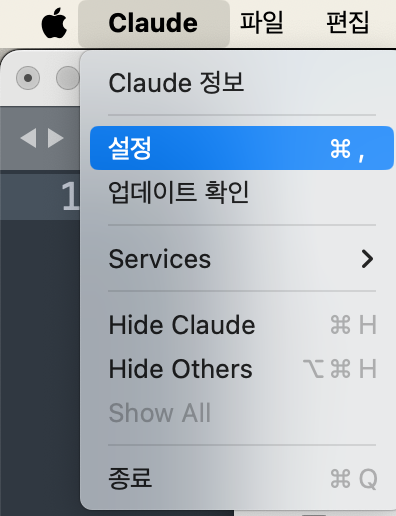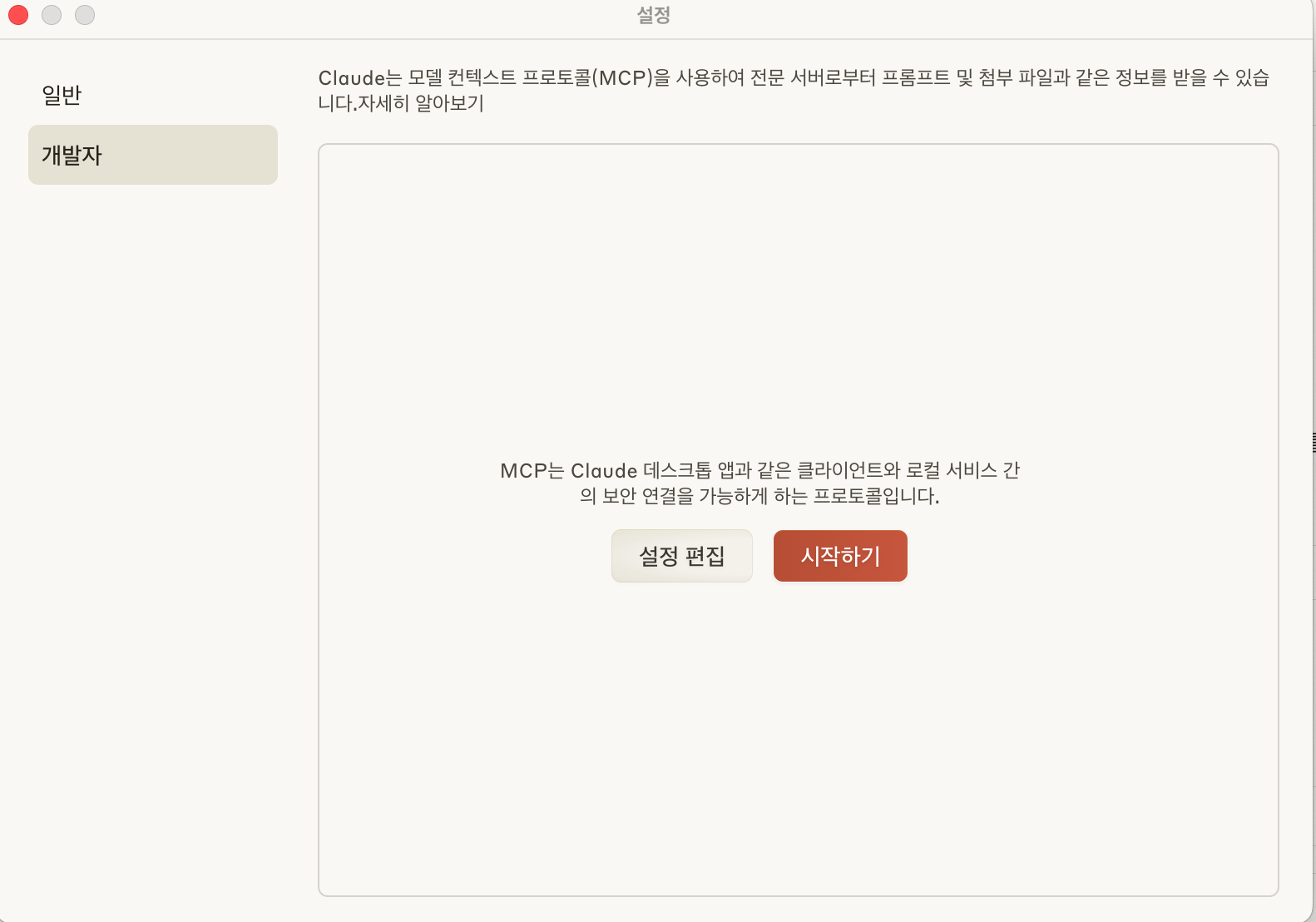MCP 서버 총정리 | 사용법 및 구축 방법 까지 10분 만에 완성하는 초보자 가이드
MCP 서버를 구축하고 설정하는 것은 처음에는 복잡해 보일 수 있지만, 올바른 가이드와 도구를 사용하면 누구나 쉽게 시작할 수 있습니다. 이 글에서는 MCP 서버의 기본 개념부터 설치, 설정, 확장 방법까지 단계별로 설명합니다. 초보자도 따라 할 수 있도록 간단하고 명확하게 작성했으니, 끝까지 읽어보세요!
MCP 서버란 무엇인가?
MCP 서버는 **MCP(모델 컨텍스트 프로토콜)**의 일부로, 대규모 언어 모델(LLM)이 외부 데이터 소스와 도구에 접근할 수 있도록 돕는 프로그램입니다. 이는 AI 시스템과 외부 시스템 간의 상호작용을 표준화하여, 데이터를 효율적으로 교환하고 작업을 수행할 수 있게 합니다.
MCP 서버의 역할
MCP 서버는 LLM이 외부 데이터와 상호작용할 수 있도록 지원합니다. 예를 들어, 파일 읽기, API 호출, 데이터베이스 접근 등을 가능하게 합니다. 이를 통해 LLM의 기능을 확장하고, 사용자 경험을 개선할 수 있습니다.
MCP 서버를 사용하는 이유
MCP 서버를 사용하면 다음과 같은 이점이 있습니다:
- 데이터 접근성 향상: LLM이 실시간 데이터에 접근 가능
- 기능 확장: 기존 AI 모델에 새로운 도구와 기능 추가
- 표준화된 통합: 다양한 LLM과 호환 가능
MCP 서버의 주요 기능
MCP 서버는 크게 세 가지 기능을 제공합니다:

- 리소스(Resources): 파일, 데이터베이스, API 응답 등 읽기 전용 데이터 제공
- 도구(Tools): 사용자 요청에 따라 실행 가능한 함수 제공
- 프롬프트(Prompts): 특정 작업을 수행하기 위한 템플릿 제공
MCP 서버 구축을 위한 사전 준비
MCP 서버를 구축하기 전에 필요한 소프트웨어와 하드웨어를 준비해야 합니다. 아래는 필수 준비 사항입니다.
필요한 소프트웨어 및 하드웨어 요구사항
- 운영 체제: Windows, macOS, Linux
- Python 3.10 이상: MCP SDK 설치를 위해 필요
- Claude Desktop: MCP 서버 테스트 및 통합 (macOS, Windows 지원)
MCP 프레임워크 다운로드 및 설치 - Python 버전
MCP 프레임워크는 MCP 서버의 핵심입니다.
Python:
# uv 설치 (권장)
curl -LsSf https://astral.sh/uv/install.sh | sh
# 프로젝트 생성 및 설정
uv init my-first-mcp-server
cd my-first-mcp-server
uv venv
source .venv/bin/activate
uv add "mcp[cli]" httpx
개발 환경 설정
VS Code나 Cursor AI 와 같은 IDE를 ��사용하면 개발 생산성을 높일 수 있습니다.
MCP 서버 구축 단계별 가이드
이제 MCP 서버를 구축하는 구체적인 단계를 살펴보겠습니다.
1. 기본 MCP 서버 구현
Python을 이용한 기본 서버 구현
- 프로젝트 생성 및 설정 방법
# 프로젝트를 위한 새 디렉토리 생성
uv init weather
cd weather
# 가상 환경 생성 및 활성화
uv venv
source .venv/bin/activate
# 의존성 설치
uv add "mcp[cli]" httpx
# 서버 파일 생성
touch weather.py
- 패키지 가져오기 및 인스턴스 설정
weather.py 파일 상단에 다음 코드를 추가합니다:
from typing import Any
import httpx
from mcp.server.fastmcp import FastMCP
# FastMCP 서버 초기화
mcp = FastMCP("weather")
# 상수
NWS_API_BASE = "https://api.weather.gov"
USER_AGENT = "weather-app/1.0"
FastMCP 클래스는 Python 타입 힌트와 독스트링을 활용하여 도구 정의를 자동으로 생성하므로 MCP 도구를 쉽게 만들고 관리할 수 있습니다.
- 헬퍼 함수
다음으로 National Weather Service API에서 데이터를 쿼리하고 형식을 지정하는 헬퍼 함수를 추가합니다:
async def make_nws_request(url: str) -> dict[str, Any] | None:
"""NWS API에 적절한 오류 처리로 요청합니다."""
headers = {
"User-Agent": USER_AGENT,
"Accept": "application/geo+json"
}
async with httpx.AsyncClient() as client:
try:
response = await client.get(url, headers=headers, timeout=30.0)
response.raise_for_status()
return response.json()
except Exception:
return None
def format_alert(feature: dict) -> str:
"""알림 기능을 읽기 쉬운 문자열로 형식화합니다."""
props = feature["properties"]
return f"""
이벤트: {props.get('event', '알 수 없음')}
지역: {props.get('areaDesc', '알 수 없음')}
심각도: {props.get('severity', '알 수 없음')}
설명: {props.get('description', '설명 없음')}
지침: {props.get('instruction', '특별한 지침 없음')}
"""
도구 실행 구현
도구 실행 핸들러는 각 도구의 로직을 실제로 실행하는 역할을 합니다:
@mcp.tool()
async def get_alerts(state: str) -> str:
"""미국 주의 기상 알림을 가져옵니다.
Args:
state: 두 글자 미국 주 코드 (예: CA, NY)
"""
url = f"{NWS_API_BASE}/alerts/active/area/{state}"
data = await make_nws_request(url)
if not data or "features" not in data:
return "알림을 가져올 수 없거나 알림이 없습니다."
if not data["features"]:
return "이 주에 대한 활성 알림이 없습니다."
alerts = [format_alert(feature) for feature in data["features"]]
return "\n---\n".join(alerts)
@mcp.tool()
async def get_forecast(latitude: float, longitude: float) -> str:
"""위치에 대한 기상 예보를 가져옵니다.
Args:
latitude: 위치의 위도
longitude: 위치의 경도
"""
# 먼저 예보 그리드 엔드포인트 가져오기
points_url = f"{NWS_API_BASE}/points/{latitude},{longitude}"
points_data = await make_nws_request(points_url)
if not points_data:
return "이 위치에 대한 예보 데이터를 가져올 수 없습니다."
# 포인트 응답에서 예보 URL 가져오기
forecast_url = points_data["properties"]["forecast"]
forecast_data = await make_nws_request(forecast_url)
if not forecast_data:
return "상세 예보를 가져올 수 없습니다."
# 기간을 읽기 쉬운 예보로 포맷팅
periods = forecast_data["properties"]["periods"]
forecasts = []
for period in periods[:5]: # 다음 5개 기간만 표시
forecast = f"""
{period['name']}:
온도: {period['temperature']}°{period['temperatureUnit']}
바람: {period['windSpeed']} {period['windDirection']}
예보: {period['detailedForecast']}
"""
forecasts.append(forecast)
return "\n---\n".join(forecasts)
서버 실행
마지막으로 서버를 초기화하고 실행합니다:
if __name__ == "__main__":
# 서버 초기화 및 실행
mcp.run(transport='stdio')
이제 서버가 완성되었습니다! uv run weather.py를 실행하여 모든 것이 제대로 작동하는지 확인하세요.
uv run weather.py
이제 기존 MCP 호스트(예: Claude for Desktop)에서 서버를 테스트할 수 있습니다.
2. 리소스(Resources) 추가하기
리소스는 LLM이 읽을 수 있는 데이터를 제공합니다. 다음은 간단한 리소스 구현 예제입니다:
Python 리소스 예제
from mcp.server.fastmcp import FastMCP
mcp = FastMCP("resource-server")
@mcp.resource_root()
async def info(request):
return {
"uri": "info://about",
"name": "서비스 정보",
"description": "우리 서비스에 대한 기본 정보"
}
@mcp.resource("info://about")
async def about_info():
return "이 서비스는 MCP 서버 예제입니다."
if __name__ == "__main__":
mcp.run(transport='stdio')
3. 도구(Tools) 구현하기
도구는 LLM이 사용자 요청에 따라 실행할 수 있는 함수입니다. 다음은 간단한 날씨 정보 제공 도구 예제입�니다:
Python 도구 예제
from mcp.server.fastmcp import FastMCP
import httpx
mcp = FastMCP("weather-server")
NWS_API_BASE = "https://api.weather.gov"
USER_AGENT = "weather-app/1.0"
async def make_nws_request(url: str):
"""NWS API에 요청을 보내는 헬퍼 함수"""
headers = {
"User-Agent": USER_AGENT,
"Accept": "application/geo+json"
}
async with httpx.AsyncClient() as client:
try:
response = await client.get(url, headers=headers, timeout=30.0)
response.raise_for_status()
return response.json()
except Exception:
return None
@mcp.tool()
async def get_forecast(latitude: float, longitude: float) -> str:
"""주어진 위치의 날씨 예보를 가져옵니다.
Args:
latitude: 위치의 위도
longitude: 위치의 경도
"""
# 예보 그리드 엔드포인트 가져오기
points_url = f"{NWS_API_BASE}/points/{latitude},{longitude}"
points_data = await make_nws_request(points_url)
if not points_data:
return "이 위치의 예보 데이터를 가져올 수 없습니다."
# 예보 URL 가져오기
forecast_url = points_data["properties"]["forecast"]
forecast_data = await make_nws_request(forecast_url)
if not forecast_data:
return "상세 예보를 가져올 수 없습니다."
# 기간을 읽기 쉬운 예보로 포맷팅
periods = forecast_data["properties"]["periods"]
forecasts = []
for period in periods[:5]: # 다음 5개 기간만 표시
forecast = f"""
{period['name']}:
온도: {period['temperature']}°{period['temperatureUnit']}
바람: {period['windSpeed']} {period['windDirection']}
예보: {period['detailedForecast']}
"""
forecasts.append(forecast)
return "\n---\n".join(forecasts)
if __name__ == "__main__":
mcp.run(transport='stdio')
4. 프롬프트(Prompts) 구현하기
프롬프트는 LLM에게 특정 작업 수행을 위한 템플릿을 제공합니다:
Python 프롬프트 예제
from mcp.server.fastmcp import FastMCP
mcp = FastMCP("prompts-server")
@mcp.prompt("이메일 작성")
def email_prompt():
return """
다음 정보로 이메일을 작성해주세요:
주제: {{subject}}
수신자: {{recipient}}
어조: {{tone}}
주요 요점:
{% for point in key_points %}
- {{point}}
{% endfor %}
"""
@mcp.prompt("블로그 글 작성")
def blog_prompt():
return """
다음 주제로 블로그 글을 작성해주세요: {{topic}}
키워드: {{keywords}}
어조: {{tone}}
길이: {{length}} 단어
대상 독자: {{audience}}
"""
if __name__ == "__main__":
mcp.run(transport='stdio')
Claude Desktop과 MCP 서버 연결하기
개발한 MCP 서버를 Claude Desktop과 연결하는 방법은 다음과 같습니다:
Claude Desktop 설정 방법
-
Claude Desktop 다운로드 및 설치
- macOS 또는 Windows용 Claude Desktop을 다운로드하여 설치합니다 (Linux는 아직 지원되지 않음)
- 이미 설치되어 있다면 Claude 메뉴에서 "Check for Updates..."를 선택하여 최신 버전으로 업데이트
-
Claude Desktop 구성 파일 설정
- Claude 메뉴에서 "Settings..." 선택 (앱 내의 Claude Account Settings가 아님)

- 왼쪽 메뉴에서 "Developer" 선택 후 "Edit Config(설정 편집)" 클릭

- 구성 파일 위치:
- macOS:
~/Library/Application Support/Claude/claude_desktop_config.json - Windows:
%APPDATA%\Claude\claude_desktop_config.json
- macOS:
- 구성 파일에 MCP 서버 정보 추가:
{
"mcpServers": {
"weather": {
"command": "uv",
"args": [
"--directory",
"절대경로/weather",
"run",
"weather.py"
]
}
}
}
- Claude Desktop 재시작
연결 확인 및 테스트
- Claude Desktop 시작
- 채팅 인터페이스에서 MCP 도구 아이콘(망치 아이콘) 클릭
- 서버 목록에서 연결할 MCP 서버 선택
- 리소스, 도구 또는 프롬프트를 사용하여 테스트
예시 명령:
- "오늘 서울의 날씨는 어때?"
- "내일 뉴욕의 날씨 예보를 보여줘."
MCP 서버 디버깅 및 문제 해결
MCP 서버 개발 시 발생할 수 있는 문제를 해결하는 방법입니다.
일반적인 문제 및 해결 방법
-
서버 연결 실패
- 파일 경로가 올바른지 확인
- 실행 권한 확인 (chmod +x)
- 구성 파일의 JSON 형식 확인
-
도구 실행 오류
- 매개변수 타입 확인
- 비동기 함수 처리 확인
- 에러 처리 추가
-
리소스 로드 실패
- URI 형식 확인
- MIME 타입 설정 확인
MCP 서버 확장 및 최적화
MCP 서버를 더 강력하게 만들기 위한 확장 및 최적화 방법입니다.
데이터베이스 연결
MCP 서버에 데이터베이스를 연결하여 동적 데이터를 제공할 수 있습니다:
import sqlite3
from mcp.server.fastmcp import FastMCP
mcp = FastMCP("db-server")
def get_db_connection():
conn = sqlite3.connect('database.db')
conn.row_factory = sqlite3.Row
return conn
@mcp.tool()
async def search_products(query: str) -> str:
"""제품을 검색합니다.
Args:
query: 검색어
"""
conn = get_db_connection()
products = conn.execute(
'SELECT * FROM products WHERE name LIKE ? LIMIT 10',
(f'%{query}%',)
).fetchall()
conn.close()
if not products:
return "검색 결과가 없습니다."
results = []
for product in products:
results.append(f"ID: {product['id']}, 이름: {product['name']}, 가격: {product['price']}원")
return "\n".join(results)
API 통합
외부 API와 통합하여 MCP 서버의 기능을 확장할 수 있습니다:
import httpx
from mcp.server.fastmcp import FastMCP
mcp = FastMCP("api-server")
@mcp.tool()
async def translate_text(text: str, target_lang: str) -> str:
"""텍스트를 번역합니다.
Args:
text: 번역할 텍스트
target_lang: 대상 언어 코드 (예: 'en', 'ja', 'zh')
"""
API_URL = "https://api.example-translator.com/translate"
API_KEY = "your-api-key" # 실제 환경에서는 환경 변수 사용 권장
async with httpx.AsyncClient() as client:
response = await client.post(
API_URL,
json={"text": text, "target": target_lang},
headers={"Authorization": f"Bearer {API_KEY}"}
)
if response.status_code != 200:
return f"번역 오류: {response.text}"
data = response.json()
return data["translated_text"]
성능 최적화 팁
MCP 서버의 성능을 개선하기 위한 팁:
-
비동기 처리 활용
- Python에서는
async/await사용 - JavaScript에서는 Promise 활용
- Python에서는
-
캐싱 구현
- 자주 요청되는 데이터 캐싱
- Redis와 같은 ��인메모리 캐시 활용
-
리소스 효율적 관리
- 커넥션 풀 사용
- 메모리 누수 방지
-
에러 처리 강화
- 예외 상황 대비
- 적절한 오류 메시지 제공
실제 사례: 날씨 정보 제공 MCP 서버
실제 작동하는 날씨 정보 제공 MCP 서버의 전체 코드입니다. 이 예제를 통해 MCP 서버의 기능을 종합적으로 이해할 수 있습니다.
from typing import Any
import httpx
from mcp.server.fastmcp import FastMCP
# FastMCP 서버 초기화
mcp = FastMCP("weather")
# 상수
NWS_API_BASE = "https://api.weather.gov"
USER_AGENT = "weather-app/1.0"
# 헬퍼 함수
async def make_nws_request(url: str) -> dict[str, Any] | None:
"""NWS API에 요청을 보내는 함수"""
headers = {
"User-Agent": USER_AGENT,
"Accept": "application/geo+json"
}
async with httpx.AsyncClient() as client:
try:
response = await client.get(url, headers=headers, timeout=30.0)
response.raise_for_status()
return response.json()
except Exception:
return None
def format_alert(feature: dict) -> str:
"""경보 정보를 가독성 있게 포맷팅"""
props = feature["properties"]
return f"""
이벤트: {props.get('event', '알 수 없음')}
지역: {props.get('areaDesc', '알 수 없음')}
심각도: {props.get('severity', '알 수 없음')}
설명: {props.get('description', '설명 없음')}
지침: {props.get('instruction', '특별한 지침 없음')}
"""
# 도구 구현
@mcp.tool()
async def get_alerts(state: str) -> str:
"""미국 주별 날씨 경보를 가져옵니다.
Args:
state: 미국 주 코드 (예: CA, NY)
"""
url = f"{NWS_API_BASE}/alerts/active/area/{state}"
data = await make_nws_request(url)
if not data or "features" not in data:
return "경보를 가져올 수 없거나 경보가 없습니다."
if not data["features"]:
return "이 주에 활성화된 경보가 없습니다."
alerts = [format_alert(feature) for feature in data["features"]]
return "\n---\n".join(alerts)
@mcp.tool()
async def get_forecast(latitude: float, longitude: float) -> str:
"""위치 기반 날씨 예보를 가져옵니다.
Args:
latitude: 위치의 위도
longitude: 위치의 경도
"""
# 예보 그리드 엔드포인트 가져오기
points_url = f"{NWS_API_BASE}/points/{latitude},{longitude}"
points_data = await make_nws_request(points_url)
if not points_data:
return "이 위치의 예보 데이터를 가져올 수 없습니다."
# 예보 URL 가져오기
forecast_url = points_data["properties"]["forecast"]
forecast_data = await make_nws_request(forecast_url)
if not forecast_data:
return "상세 예보를 가져올 수 없습니다."
# 기간을 읽기 쉬운 예보로 포맷팅
periods = forecast_data["properties"]["periods"]
forecasts = []
for period in periods[:5]: # 다음 5개 기간만 표시
forecast = f"""
{period['name']}:
온도: {period['temperature']}°{period['temperatureUnit']}
바람: {period['windSpeed']} {period['windDirection']}
예보: {period['detailedForecast']}
"""
forecasts.append(forecast)
return "\n---\n".join(forecasts)
# 서버 실행
if __name__ == "__main__":
mcp.run(transport='stdio')
결론
MCP 서버는 AI 모델과 외부 시스템을 연결하는 강력한 도구입니다. 이 가이드에서는 MCP 서버의 기본 개념부터 구축, 설정, 확장까지 단계별로 알아보았습니다.
이제 여러분은 다음을 할 수 있게 되었습니다:
- MCP 서버의 핵심 개념 이해
- 기본 MCP 서버 구축
- 리소스, 도구, 프롬프트 구현
- Claude Desktop과 연결 설정
- 문제 해결 및 디버깅
- MCP 서버 확장 및 최적화
MCP 기술은 계속 발전하고 있으며, 이를 통해 AI 모델의 가능성이 더욱 확장될 것입니다. 이 가이드가 여러분의 MCP 서버 구축 여정에 도움이 되길 바랍니다!